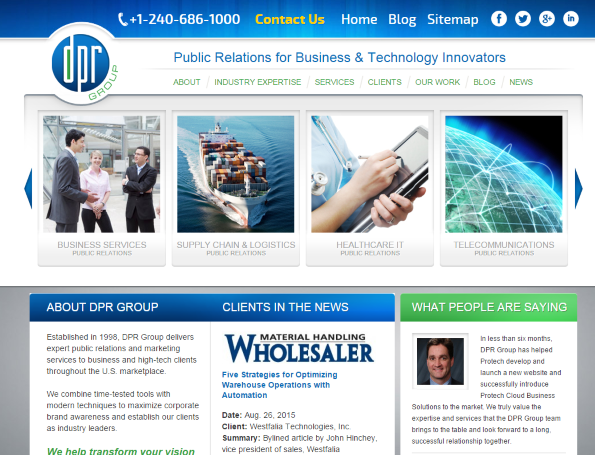By Dan Demaree
Frustration is a powerful motivator. It drives us to make the changes necessary to move our businesses forward. But some changes require up-to-date technology to power the business. My company, DPR Group, Inc., a full-service public relations, marketing and communications agency, was stuck in a technology rut that stymied our productivity and limited our growth. Our frustration culminated just before we broke free of the break-fix model of managed services and leaped ahead with cloud computing.
Growing a Small Business
I founded DPR Group with a vision to open small satellite offices in technology hubs throughout the eastern United States. At the time of my technology challenge, I had expanded to two offices for nearly 15 employees with our headquarters in Germantown, Maryland, and a second office in Cary, North Carolina.
However, providing expert public relations and marketing services to high-tech companies requires a strong technology infrastructure to effectively communicate with our clients. Without an on-site IT resource, one of our obstacles to growth was finding a way to keep all our in-house technology running smoothly.
Technology Issues Can Weigh Down a Business
For four years, we worked with a managed services provider to help maintain our PCs, a Dell PowerEdge Server, and internal networks in both of our offices. Although the CEO of our managed services provider spoke eloquently about his company’s preventative approach to computer maintenance, they actually spent far more time trying to fix things after they broke.
The DPR Group left break-and-fix tech support behind and moved its IT infrastructure to the cloud with good results.
This resulted in a number of issues that challenged our ability to maintain the high-level client service that we offer. Downtime, latency, reliability, and accessibility were just a few reoccurring issues. For example, our managed services provider would frequently run software updates on Sunday nights and, due to compatibility issues with the updates and a lack of testing, the server would often crash on Monday mornings. This left our staff scrambling to work from back-up files, while the managed services provider attempted to fix the problem.
Also, when working remotely, our staff used Virtual Private Networks (VPNs) with severe latency and connectivity issues that caused delays and required additional time to complete basic tasks such as reconnection, file uploads, or even simply writing an email.
Our managed services provider also experienced a lot of personnel turnover. Every time someone new started working on our account, we would have to re-explain everything about not only the issue we were having, but also how our entire system was set up because the “new expert staff” was not familiar with our system.
Not unexpectedly, I received daily complaints from my staff about how technology issues were making it difficult for everyone to do their job effectively. After discussing specific challenges with each of my staff members, I calculated that every employee was losing from seven to nine days of productivity per year due to time spent waiting for a tech to fix the problems. I finally said, “Enough is enough. There has to be a better option!”
Selecting the Right Cloud Provider
I started my search for a new vendor by talking with a number of managed services providers that all promised to do a much better job of maintaining our computers and networks. More importantly, I started hearing the term “cloud computing,” and learned that it could streamline a lot of processes and significantly improve our productivity. Although I thought the cloud might be a better model for us, I worried that we also would need a local IT resource to maintain the basic hardware in our two different offices.
After reviewing proposals from a number of providers within the Washington, D.C., metro area, I selected Virgina-based Cetrom Information Technology to take us to the cloud. This cloud computing service provider stood out from the rest for a few primary reasons. First, Cetrom offered a truly hosted cloud model. Other cloud providers would host data on the cloud, but install applications locally. It was either that, or we would have to use limited-functionality, software-as-a-service (SaaS) versions of our standard software. Cetrom, however, hosted the full, traditional versions of our software in the cloud and seamlessly mirrored a local environment.
Though Cetrom provides exceptional backup services—multiple, geographically dispersed, U.S.-based data centers and daily tape backups—the company also offers a hybrid option for an added layer of redundancy. The Cetrom Hybrid places a small server on site in my headquarters that replicates the data to and from the cloud in real time. It gives me peace of mind, since I was previously used to having all our IT within the office.
Also, Cetrom’s senior-level engineers really took the time to understand our business goals and processes during roll out. From there, they designed our cloud solution—with strong business continuity and disaster recovery plans, and easy access to key applications—around our business, instead of making us adapt to a rigid, out-of-the-box solution.
When discussing our IT needs with Christopher Stark, Cetrom’s CEO, he said, “We find that 90 percent of companies want most of the same features, but customizing the remaining 10 percent is the icing on the cake that personalizes the implementation and ensures it’s a perfect match for each of our clients.”


